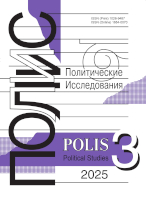How to Measure Soft Power in International Relations
Gallarotti G.M.,
Professor, Department of Government, Wesleyan University, ggallarotti@wesleyan.edu
DOI: 10.17976/jpps/2020.01.07
Gallarotti G.M. How to Measure Soft Power in International Relations. – Polis. Political Studies. 2020. No. 1. https://doi.org/10.17976/jpps/2020.01.07
This paper provides suggestions on how to properly operationalize “soft power” in international relations and organize the measures into categories that are more favorable for quantitative analyses. While we mention several existing indexes, analysis concentrates on the best known and most extensively applied index of “soft power”: The “Soft Power”30 Index. So far, the actually measures used for quantitative analysis based on these most popular data sets have been flawed. This paper attempts to illuminate these flaws and prescribes solutions for improving the measures. In this respect, the paper serves as an important prelude to quantitative studies of soft power. This paper is organized as follows: first, the author presents the leading measures of soft power by data base and content of each. Then he identifies flaws in measuring “soft power” and prescribes better measures. The last section offers brief concluding remarks.
References
Chatin M., Gallarotti G. 2016. The BRICS and Soft Power: An Introduction. – Journal of Political Power. Vol. 9. No. 3. P. 335-352. https://doi.org/10.1080/2158379x.2016.1232284
Elenco Global Presence Report 2015. Coordinators: L. Olivie. C. Garcia-Calvo, M Gracia. 2015. Madrid: Real Instituto Elcano. URL: http://www.realinstitutoelcano.org/wps/wcm/connect/f36b5f004830c24a8e3b8fe0dd72d861/Global_Presence_2015.pdf?MOD=AJPERES&CACHEID=f36b5f004830c24a8e3b8fe0dd72d861 (accessed 16.12.2019).
Kurlantzick J. 2007. Charm Offensive: How China’s Soft Power is Transforming the World. New Haven: Yale University Press.
McClory J. 2012. The New Persuaders III. A 2012 Global Ranking of Soft Power. London: Institute for Government. 15 p. URL: https://www.instituteforgovernment.org.uk/sites/default/files/publications/The%20new%20persuaders%20III_0.pdf (accessed 16.12.2019).
Trunkos J., Cerny Ph. 2018. Operationalization Soft Power from Latent to Manifest. Paper delivered at the annual meeting of the International Political Science Association, Brisbane, Australia, July 20-24.
See also:
Kostyrev A.G.,
The intelligent power, public diplomacy, and social networks as a factors of international politics. – Polis. Political Studies. 2013. No2
Liu Zaiqi,
«Soft Power» in China’s Development Strategy. – Polis. Political Studies. 2009. No4
Lebedeva M.M., Zinovieva E.S.,
Methods of neuroscience in studying world politics. – Polis. Political Studies. 2023. No5
Andreyev A.L.,
“Soft Power”: Arrangement of Senses, Russian Style. – Polis. Political Studies. 2016. No5
Pavlova E.B., Romanova T.A.,
Normative Power: Some Theory Aspects and Contemporary Practice of Russia and the EU. – Polis. Political Studies. 2017. No1





.jpg)






 print
print
.jpg)
.jpg)